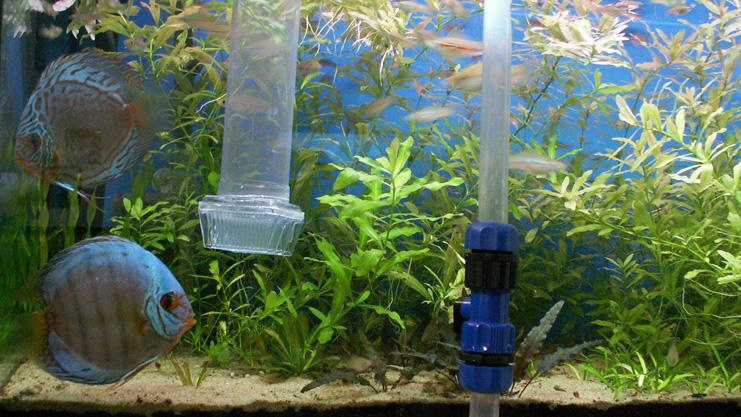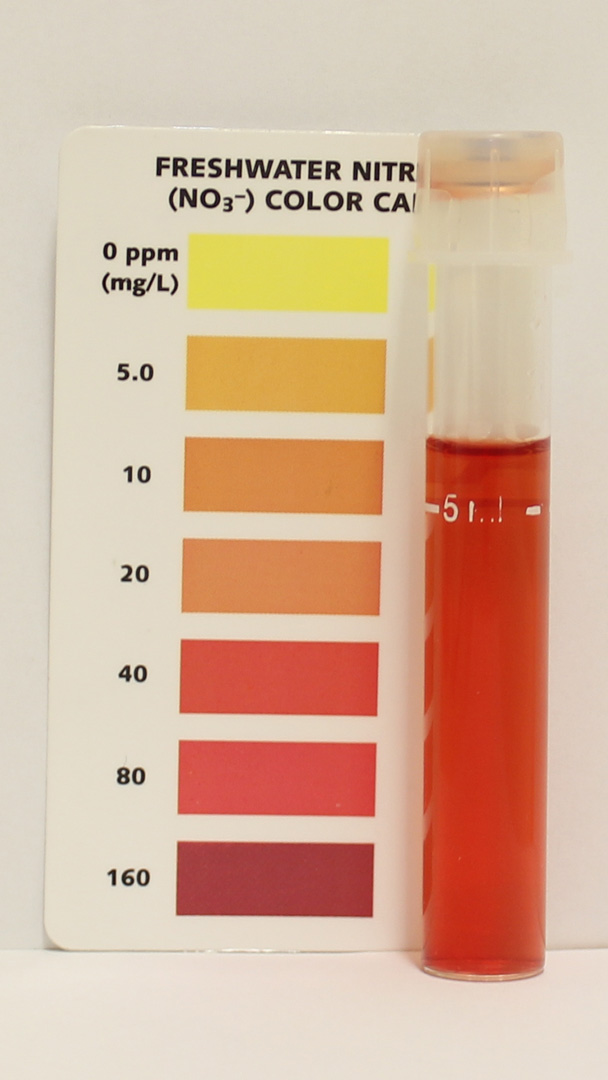One of the most important factors in maintaining a healthy aquarium or pond is performing water changes on a schedule. Depending on who you ask, you can get a response of 25% monthly to 90% daily. What needs to be understood more widely is why water changes are important and what you accomplish when doing one.

Why is old water bad, and how do you know when your water is old? Water out of the tap normally has 0 ppm ammonia, 0 ppm nitrite, and 0 ppm to <4 ppm nitrate. Nitrate levels tend to rise over time in an "established" (completed the nitrogen cycle) aquarium or pond. How fast nitrate accumulates is highly variable. Nitrate is formed by the bacterial action on waste from the animals and the decomposition of plant matter. The aerobic bacteria, known as Nitrosospira and Nitrospira, help break down the waste in an aquarium or pond from ammonia, to nitrite, and then into nitrate.
If you have a heavily stocked tank or pond, your nitrate level can quickly accumulate. Aquariums and ponds can be designed to slow down nitrate accumulation by having live plants, deep sand bed (DSB), refugium (with DSB and Macro Algae), algae scrubber, or a denitrator filter. If you have none of these nitrate-reducing elements in your tank or pond ecosystem, the nitrate can quickly accumulate.
If you have two or more 10-inch (25 cm) Oscars (Astronotus ocellatus) in a 50-gallon (190 l) aquarium, your nitrate levels will accumulate very quickly. A 25% water change monthly will not be sufficient and will likely lead to a condition known as Hole In The Head (HITH) disease, common in Oscars because of the significant amount of nitrate that accumulates in tanks with these large fish. The quantity of nitrate in the system determines when your water is old.
Myth Buster
An aquarium and pond myth that is floating around that says Nitrosomonas and Nitrobacter break down ammonia and nitrite in an aquarium and pond. There are a lot of aquarium products that are produced by many aquarium product manufacturers based on this myth for seeding new tanks and ponds with good bacteria. These products do not work because they do not have the right bacteria. The correct bacteria are Nitrosospira and Nitrospira, Dr. Tim's One and Only is one product with the correct species.
The lower your nitrate level, the better it is for your fish and invertebrates. All species of fish and invertebrates have different tolerant levels to nitrate.
Most freshwater and marine fish can tolerate short-term exposure (less than two weeks) to 100 ppm nitrate, but any higher long-term exposure (greater than two weeks) can cause health problems with sensitive fish like Purple Tangs (Zebrasoma xanthurum). My current recommendation for the maximum nitrate level for fish is 100 ppm. In reef aquariums where Clownfish "Host Anemones" are kept, my recommendation is below 20 ppm nitrate.
How much water to change and on what type of schedule will depend on the bio-load of the aquarium or pond and any nitrate-reducing factors you have implemented, if any. In some well-established reef aquariums that have low bio-load and use DSB, refugium, denitrator, and or algae scrubbers, it is not all that uncommon for nitrate levels to accumulate very slowly or not at all. In a reef aquarium where nitrate levels are undetectable, I recommend at least a 50% water change once every 6 months to replace any minor trace elements that may be used up by the reef inhabitants. Marine fish with Marine Head and Lateral Line Erosion (MHLLE or HLLE) can have their condition reversed if they are moved to a tank that is able to maintain its nitrate below 40 ppm.
Myth Buster
An aquarium and pond myth floating around says not to do a large water change as this removes too much beneficial bacteria. This is not true. Beneficial bacteria that break down ammonia and nitrite live on the surface area within the tank/pond and filtration system, it does not live in the water column. That is why many filters on the market today have some sort of biological filter media, like Bio-Wheel filters, trickle filters, sponge filters, and canister filters. These filters have large amounts of surface area for nitrifying bacteria to colonize.
Most aquariums and ponds are not able to maintain low nitrate levels. Whenever you do a water change, it is recommended that you change out at least 50% at a time to reduce the nitrate concentration by 50%. Generally, the percentage of water you change is equivalent to the rate of nitrate reduction. If your nitrate level is 100 ppm and you need to get it down to below 20 ppm to keep that anemone you have wanted to get for your Clownfish, you need to do at least an 80% water change to get it down below the target level. Two 40% water changes will not get you down to <20 ppm; it will only get you to 36 ppm.
In most cases, the larger the water change you can do, the better, with one exception. Aquariums with high nitrate levels often have a low pH. A large water change in an aquarium with a low pH can cause fish mortality within 24 hours from a condition called "pH or Osmotic Shock." When large quantities of water are replaced in an aquarium, this often increases pH. In systems with strong buffering, like marine aquariums, the risk of pH shock is less than with freshwater. Low carbonate hardness (KH) in freshwater has a poor buffering capacity, so check the pH before you do a large water change. In this case, several small water changes (25%) over several days to slowly bring up the pH before a large water change is done will help the fish adjust to the higher pH/KH slowly.
Tip - First Aid for pH/Osmotic Shock
pH/osmotic shock" in fish has visible symptoms. Fish exhibiting pH//osmotic shock will lay on the bottom of the tank, often on their side, and breathing abnormally heavily. This condition can be reversed provided you return the fish to the pH/osmotic pressure to the level it was acclimated. It can take several days to recover, so if you put the fish in a tank with fish, make sure you isolate the fish in a plastic critter container or a hang-on-the-tank breeder net. Fish with pH/osmotic shock is not very mobile and can easily be picked on and killed by other fish in the tank.
You should test your nitrate level after you have done a water change to find out what level it is at and make a note of the date and result. One week later, check the nitrate level again and subtract the nitrate result you took after the water change from your current nitrate result. If your nitrate accumulated 20 ppm in that time,, you know how fast it accumulates in your tank. If you started with 20 ppm nitrate, you have four weeks before your tank reaches 100 ppm, at which time you should do at least an 80% water change to get at or below 20 ppm. When I do a water change on my tanks or pond, I drain the water down to just enough to give the fish enough water to keep them wet, and then I fill it back up with dechlorinated water.
Tip - Word of Warning

The main reason behind water changes is nitrate reduction. Most Freshwater and Saltwater Master Test Kits come with a nitrate test kit, but they can also be purchased separately. Nitrate should be tested at least once a month and before and after water changes so you can get an idea of how fast nitrate accumulates in your system. Nitrate test kits come in powder, liquid, and test strip forms. My personal preference is the liquid test kits. They are easy to use and are accurate enough to make a reasonable estimate of how often you should make a water change and how much you need to change.
If you are testing your nitrate for the first time, you may be surprised that your nitrate level is off the scale. If this is the case, for freshwater, you will need to cut 1 part sample water with 3 parts of tap or distilled water (or a known water source with 0 nitrate), and for saltwater you will need freshly mixed saltwater with a nitrate level of 0 ppm. Once you have completed the test and have a legible reading, multiply the result by 4 to get the actual result. You may have to cut the sample water even more to get a legible result. On several occasions, sample water I have tested had to be cut by 20 times to get a legible result.
Water changes are the key to long-term health of a closed aquatic environment. Nitrate reduction through water changes is a must for most closed systems. Put your nitrate test kit to work to monitor the overall health of the closed system. When you do your water changes, remove the water from the water column, and try not to disturb the sand or gravel bed too much, as this can lead to ammonia and nitrite spikes a few days after.
